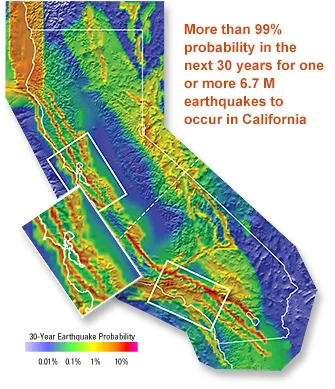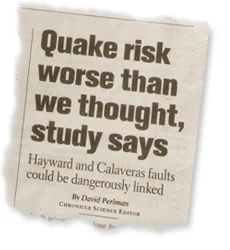Bay Area earthquake hazards
Forecasting California’s Earthquakes
California has more than a 99% chance of having a magnitude 6.7 or larger earthquake within the next 30 years, according to scientists using a new model to determine the probability of big quakes.

For northern California, the most likely source of such earthquakes is the Hayward-Rodgers Creek Fault (31% in the next 30 years). Such quakes can be deadly, as shown by the 1989 magnitude 6.9 Loma Prieta and the 1994 magnitude 6.7 Northridge earthquakes.
The new study determined the probabilities that different parts of California will experience earthquake ruptures of various magnitudes. The new statewide probabilities are the result of a model that comprehensively combines information from seismology, earthquake geology, and geodesy (measuring precise locations on the Earth’s surface). For the first time, probabilities for California having a large earthquake in the next 30 years can be forecast statewide.
For Additional Information:
SCEC » A New Forecast of California Earthquakes
The Working Group on California Earthquake Probabilities forecast
Earthquake Forecasting, Hazards and Risk
USGS » Forecasting California’s Earthquakes
What Can We Expect in the Next 30 Years?
PDF / 4 pages / 1.7mb
For Recent Earthquake Information:
Real Time Earthquake Map
USGS — Latest Earthquake Information from Around the World
Greater Shaking Intensity in the Bay Area
A major quake can occur at any time, in any part of this densely populated region. The epicenter of the 1989 Loma Prieta earthquake was in the Santa Cruz Mountains, distanced some 30-70 miles from Bay Area cities. The USGS warns that should an earthquake strike at one of the closer fault areas, such as the Hayward fault, shaking in local cities can be expected to be 5 to 12 times stronger than it was in 1989. Therefore, there is an ongoing need for all communities to continue preparing for the quakes that will strike in the future.
Bay Area Quake Probability Map
Using newly collected data and evolving theories of earthquake occurrence, U.S. Geological Survey and other scientists now conclude that there is a 63% probability of at least one magnitude 6.7 or greater quake, capable of causing widespread damage, striking somewhere in the San Francisco Bay region in the next 30 years. Such an earthquake is most likely to occur on one of seven main fault systems. The earthquake probability is highest for the Hayward-Rodgers Creek Fault system, 31%, or nearly 1 out of 3.
Understanding Earthquake Hazards in the Bay Area
USGS » 2016 Bay Area Earthquake Outlooks
Community-Wide Effects
The Association of Bay Area Governments (ABAG) estimates that after an earthquake a potential housing loss to Bay Area communities of over 159,000 units. This would have disastrous effects on our local and regional economies. It also means that recovery, repair and rebuilding time for every household will be very lengthy, due to the number of homes that will need repairs or replacement. Households that are less damaged will certainly make much faster recoveries.

Earthquake Preparedness
The Importance of Earthquake Retrofitting
The cost of earthquake insurance has increased dramatically. At the same time, benefits have decreased. Many homeowners have made a conscious choice to accept the earthquake risk personally by declining earthquake coverage. Governmental resources to help with damage recovery, especially at the personal level, are declining. All these factors, together, make it even more critical to focus on the prevention of earthquake-related damages.
Based on extensive post-earthquake evaluations, experts agree that structural damage can be greatly reduced by following recommended practices of seismic retrofitting. Retrofitting will reduce the cost of repair, and may even prevent structural damage altogether. The benefits go well beyond being simply financial. It will make your home safer and help to keep it habitable following a major disaster. It will also reduce the amount of time and effort needed for recovery, returning your family much more quickly back to your normal life style.
